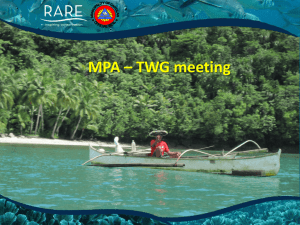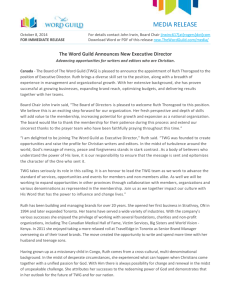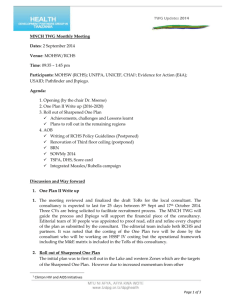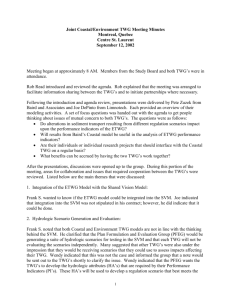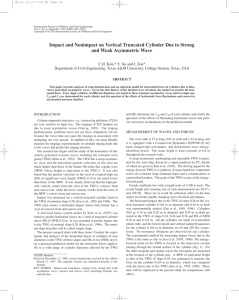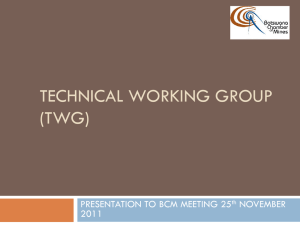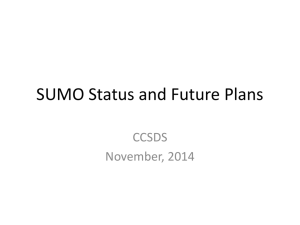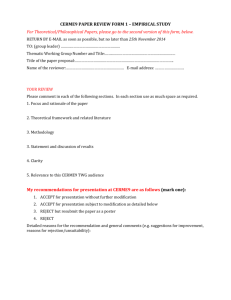SWAp TWGs Report
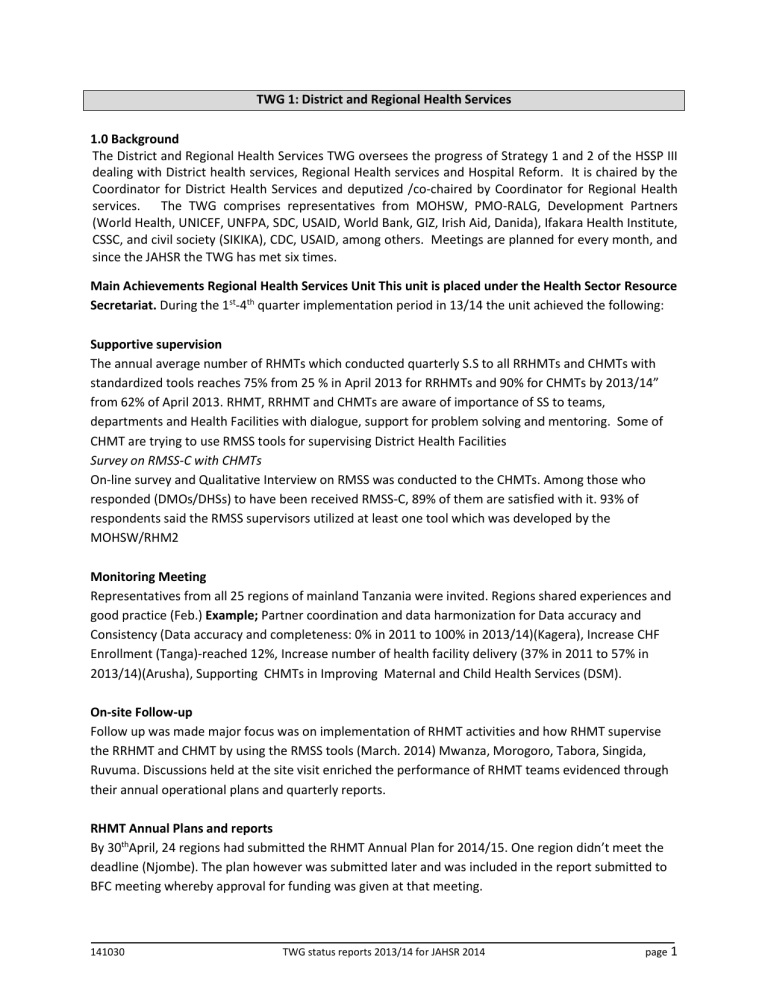
TWG 1: District and Regional Health Services
1.0 Background
The District and Regional Health Services TWG oversees the progress of Strategy 1 and 2 of the HSSP III dealing with District health services, Regional Health services and Hospital Reform. It is chaired by the
Coordinator for District Health Services and deputized /co-chaired by Coordinator for Regional Health services. The TWG comprises representatives from MOHSW, PMO-RALG, Development Partners
(World Health, UNICEF, UNFPA, SDC, USAID, World Bank, GIZ, Irish Aid, Danida), Ifakara Health Institute,
CSSC, and civil society (SIKIKA), CDC, USAID, among others. Meetings are planned for every month, and since the JAHSR the TWG has met six times.
Main Achievements Regional Health Services Unit This unit is placed under the Health Sector Resource
Secretariat. During the 1 st -4 th quarter implementation period in 13/14 the unit achieved the following:
Supportive supervision
The annual average number of RHMTs which conducted quarterly S.S to all RRHMTs and CHMTs with standardized tools reaches 75% from 25 % in April 2013 for RRHMTs and 90% for CHMTs by 2013/14” from 62% of April 2013. RHMT, RRHMT and CHMTs are aware of importance of SS to teams, departments and Health Facilities with dialogue, support for problem solving and mentoring. Some of
CHMT are trying to use RMSS tools for supervising District Health Facilities
Survey on RMSS-C with CHMTs
On-line survey and Qualitative Interview on RMSS was conducted to the CHMTs. Among those who responded (DMOs/DHSs) to have been received RMSS-C, 89% of them are satisfied with it. 93% of respondents said the RMSS supervisors utilized at least one tool which was developed by the
MOHSW/RHM2
Monitoring Meeting
Representatives from all 25 regions of mainland Tanzania were invited. Regions shared experiences and good practice (Feb.) Example; Partner coordination and data harmonization for Data accuracy and
Consistency (Data accuracy and completeness: 0% in 2011 to 100% in 2013/14)(Kagera), Increase CHF
Enrollment (Tanga)-reached 12%, Increase number of health facility delivery (37% in 2011 to 57% in
2013/14)(Arusha), Supporting CHMTs in Improving Maternal and Child Health Services (DSM).
On-site Follow-up
Follow up was made major focus was on implementation of RHMT activities and how RHMT supervise the RRHMT and CHMT by using the RMSS tools (March. 2014) Mwanza, Morogoro, Tabora, Singida,
Ruvuma. Discussions held at the site visit enriched the performance of RHMT teams evidenced through their annual operational plans and quarterly reports.
RHMT Annual Plans and reports
By 30 th April, 24 regions had submitted the RHMT Annual Plan for 2014/15. One region didn’t meet the deadline (Njombe). The plan however was submitted later and was included in the report submitted to
BFC meeting whereby approval for funding was given at that meeting.
141030 TWG status reports 2013/14 for JAHSR 2014 page 1
The new features for RHMT quarterly report and review
Officials from MOHSW who will be assessing the RHMT quarterly reports were re-oriented on the new features of RHMT quarterly report as included in the RHMT Planning and Reporting Guideline which was introduced through RHMT training since November 2013. The use of new quarterly report template started from the third quarter report.
Terminal Evaluation and JCC
Terminal Evaluation Mission conducted the Joint Terminal Evaluation for the RHM2 project from 3 rd to
17 th of April. .The mission presented the report at the 4 th JCC meeting.
Revision of “Functions of Regional Health Management System”
Through the review based on the inputs collected at the RHMT Monitoring Meeting in February 2013, the revision process reached the stage of finalization and approval. The document was signed by
MOHSW and PMORALG in April 2014.
Development of Standardized Tools and Procedure of the Supportive Supervision
During the period reported, further developed RMSS Manual containing RMSS-C and RHMSS-H
RMSS-C has been implemented since the fourth quarter of 2012/13 (April-June 2013). The development of RMSS-H was delayed due to lack of clarity of MOHSW’s position on how it should relate to the
Comprehensive Hospital Operational Plan (CHOP). As the senior management including the directors and CMO indicated the RMSS-H should be based on CHOP, the standardized tools were finalized accordingly. The contents of MRSS Manual containing both RMSS-C and RMSS-H were finalized by
December 2013, was submitted to technical proof reading in January 2014. The document was approved and signed by MOHSW in May 2014.
RHMT Planning and Reporting Guideline
Based on the RHMT Planning Guide developed in the 1 st phase project, the guidance has been revised to suit the current needs. . The new RHMT planning and reporting formats in the draft guideline have increased emphasis on the situation analysis and support of the councils and Regional Referral Hospitals.
As a part of development of the guideline, an assessment criterion for RHMT Quarterly Report has been developed and is in use.
Dissemination Activity
In order to disseminate the roles and functions of RHMT to the stakeholders, the newsletter is published covering the activities of the RHM2 project and RHMT. During the period under report, the volume 5 of the newsletter was printed and distributed. The contents included interview to the new Minister for
Health and Social Welfare, messages from Regional Administrative Secretaries who attended the 2 nd
RHMT Monitoring Meeting, the result of survey of CHMT on RMSS-C, introduction of RHM2 materials and report on the training in Japan.
141030 TWG status reports 2013/14 for JAHSR 2014 page 2
Main Achievements District health Services
RHMTs Training short term outcomes
PlanRep3 Health Meso for RHMTs were developed and rolled out in 25 regions
Number of RHMTs submitted CCHP performance progress reports using electronic system
(PlanRep3) increased from 0% to 100%.
Quality CCHP Performance Summary analysis report for 2012/2013 from 25 regions were produced using Planrep3
Quality and timely Comprehensive Council Health Plan summary analysis Report for 2014/2015 from 25 regions were produced using PlanRep3
Carried over budget and expenditure from 162 councils were reported for financial year 2013/14 using Planrep3
Quality and timely annual and 4 th quarter CCHP Performance progress reports for 2013/2014 were submitted from 162 council using Planrep3
Number of councils submitted their plans and performance progress reports using Planrep3
increased from 41.7% (132) 2011/2012 to 100% (162) 2014/2015.
Quality and timely CCHPs 2014/2015 from 162 councils were submitted timely and CCHP summary analysis for 2014/15 plans was prepared and approved timely. Assessment round of the CCHPs was up to the third round compared to last year which was up to the fourth round.
Hospital Reform>
Fifteen HMTs have developed and submitted their Comprehensive Hospital Operation plans (CHOP) for year 2014/15 to the MOHSW.
-CHOP guidelines have been reviewed to incorporate inputs/ issued raised by HMTs and RHMTs after using the guideline to develop plans.
-Assessment criteria to be used by the MOHSW and RHMTs to assess CHOPs developed and circulated to RHMTs. The criteria has been used to assess 2014/15 plans.
-Quarterly and annual implementation reports, guidelines developed and disseminated to HMTs.
Few hospitals have started using the guidelines to develop quarterly implementation reports.
- Specialist medical doctors have continued to be deployed to Regional referral hospitals and currently 13 RRH have four or more than four specialist doctors.
-17 Regional Referral hospitals have functional Regional Hospital Advisory boards.
141030 TWG status reports 2013/14 for JAHSR 2014 page 3
TWG 2: Human Resources for Health
The Ministry of Health and Social welfare have continued to post new health workers to various employment authorities such as Permanent secretaries, Regional Administrative Secretaries (RAS) and
Directors in the Local Government Authorities (DED etc). The posting is done after getting recruitment permit from the President’s Office Public Service Management (POPSM). By the end of June 2014 there were a total of 64,240 health workers in the HRHIS.
The Ministry was given recruitment permit to post 11,221 new health workers to various employers in the country, the exercise of posting and recruitment of new health workers was done and 9,811 new health workers were posted. The HRHIS shows that, there were 70,244 health workers by September
2014, among them 54,627 workers were from the public facilities and institutions, Private for Profit had
1,547 workers and Faith Based organization had 14,070. The total number of HRH required to man the facilities is 145,454. The records of HRH available in the HRHIS are used to show HRH Data disparities among regions, districts and even in facilities of the same levels.
Country wide HRHIS data coverage is 94.7%, all regions have more than 80% with exception of Mara region which have entered 77%. In strengthening the HRHIS reliability, the MoHSW in collaboration with the Computer Science Department of the University of Dar es Salaam conducts supportive supervision to all district councils and regions. The findings from the supportive supervision are used to improve data management, data analysis and reports utilization. The Regional Health Management Teams also play the same role in their routine supervision whereby the district councils are supervised and advised on important issues which will improve and sustain the HRHIS.
The challenges facing HRHIS includes slowness in data entry and updating especially data from the private health facilities, lack of reliable source of power (electricity) to run the internet computer all the time, transfers of HRHIS trained personal and some district does not allocate funds to pay for internet connectivity.
141030 TWG status reports 2013/14 for JAHSR 2014 page 4
TWG 3: Health Care Financing
3.1 Background
The Health Financing TWG oversees the progress of Strategy 5 of the HSSP III dealing with Health Care
Financing. It is chaired by the MOHSW Assistant Director Policy, and co-chaired by the Assistant
Director Budget and Planning. The TWG comprises representatives from MOHSW, PMO-RALG, MOF,
NHIF, Development Partners (USAID, World Bank, GIZ/P4H, Irish Aid, Danida), Ifakara Health Institute,
APHFTA, CSSC, and civil society (SIKIKA), among others. Meetings are planned for the 2 nd Tuesday of each month, and since the JAHSR 2013 the TWG has met eight times.
3.2
Main achievements since the JAHSR 2013 a.
Health Financing Strategy development
Dec 2013 - Finalisation of additional papers on Provider Autonomy and Health Insurance
Institutional Assessment , and subsequent presentation to the Inter-ministerial Steering Committee
(ISC); externally facilitated workshop on the implications of ISC-preferred options for the insurance market on the other areas
March 2014 - Consultative meetings with different stakeholder groups on the preferred options
(district and regional health and other local government officials, MDAs, DPs, NGOs and civil society,
Parliamentarians)
May 2014 – internal HFS drafting workshop culminating in zero draft
Sept 2014 – consultative meeting to present draft Fiscal Space study, and zero draft HFS; presentation to Senior Management;
Oct 2014 - drafting workshops to elaborate on and tighten up draft b.
Roll-out of Results-Based Financing
Nov 2013 – externally facilitated training of govt officials from MOHSW, PMO-RALG, MOF, PO-PSM
Dec 2013 – establishment of new RBF team
Jan 2014 – RBF team meeting with WB on re-design
Febonwards – work on re-design
Mar 2013 – presentation to TC-SWAp
Aug/Sept 2014 – social, institutional and PFM assessments undertaken
Oct 2014 – circulation of revised draft design document to TWG c.
Resource tracking
NHA – completion of data entry and analysis for FY2011/12. Results presented within TWG (IOct
2014) and to be presented at the JAHSR 2014.
PER – data entry and analysis largely complete for FY 2012/13. Draft circulated among HF TWG members for comment. Initial presentation of FY 2013/14 data made to TWG (Oct 2014) d.
Other activities
Mar 2014 –revision of resource allocation formula finalized and used for FY2014/15 Health Basket
Fund allocations; meetings in Sept 2014 with PMO-RALG team undertaking broader review of grants
June 2014- Externally facilitated training of MOHSW and PMO-RALG officials on the OneHealth planning and costing tool as first step in its use for HSSP IV development
June 2014 – 2 HFU officials attended advanced health financing course
141030 TWG status reports 2013/14 for JAHSR 2014 page 5
3.3 Major challenges and constraints
Regular absence of key members (e.g. MOF, PMO-RALG, NHIF) from meetings.
3.4 Way forward
Finalisation of NHA 2011/12 and PER 2012/13, and initiation of PER and NHA FY2013/14
Finalisation of HFS and submission to Cabinet by end of 2014
RBF pre-pilot of new design in Kishapu DC in Shinyanga region
TWG 4: Public Private Partnership
4.1 Background
The PPP TWG oversees the progress of Strategy 6 of the HSSP III dealing with Public Private Partnership
(PPP). Its composition includes representatives from Faith Based Organisations (CSSC, BAKWATA),
Private Health Providers (APHFTA), Development Partners (DANIDA, USAID, GIZ, UNICEF), Government
(MOHSW, PMO RALG), Health Professionals (TPHA) and Civil Society. The TWG is chaired by the
MOHSW PPP Coordinator and Deputy Chair is the TPHA representative. The TWG planned to meet monthly and managed to meet eight times as TWG and three times for the Public-Private Health Forum
Executive Board meetings since November, 2013. The PPP TWG collaborates with other TWGs and taskforces, including TC SWAp.
4.2
Main achievements towards HSSP III PPP Strategies since the JAHSR 2013 e.
To ensure conducive policy and legal environment to facilitate PPP operations
Advocacy and dissemination of PPP documents and other MOHSW strategies and guidelines, relating to PPP in 10 regions (100%) (Manyara, Singida, Njombe, Mtwara, Geita, DSM, Katavi,
Rukwa, Kagera and Mara) and 3 National Hospitals (MNH, MOI & ORCI) conducted, out of 10 planned regions and 3 National Hospitals, there was a total of 280 public and private sector participants.
PPP advocacy and dissemination meetings were held in 24 councils through CSSC in collaboration with the PPP sub-unit in the MOHSW.
Consultants contracted to support the strengthening of coordination of traditional and alternative medicine providers through the Traditional Medicine Section of the MOHSW, work nearing completion. f.
To ensure effective management and operational framework for PPP
The Tanzania Public-Private Health Forum was institutionalized and was officially launched by the
Minister of Health and Social Welfare on 24 th April, 2014. Action plan developed to institutionalize
Public Private Health Forums at all levels, support to operationalise the Resource Centre is now being sought.
The consultants for conducting a PPP data base, Public and Private Social Welfare Services mapping and PPP Pipeline in place and work ongoing an nearing completion.
A PPP communication strategy for health and social welfare was developed and next step will be to operationalise this strategy.
141030 TWG status reports 2013/14 for JAHSR 2014 page 6
g.
To enhance PPP in the provision of health and social welfare services
To date 87 health facilities have signed service agreements, being 66 hospitals and 21 health centre/dispensaries.
A draft Memorandum of Understanding is developed amongst the MOHSW, PMO-RALG and CSSC to govern the upgraded 10 FBO Referral Hospitals at Regional Level (RHRL) and forwarded to POPSM,
PMO-RALG and MOF for their inputs and comments.
8 Members of the PPP TWG, 2 MOHSW officials and more than 60 participants from the Tanzania private health sector, participated in the third East African Healthcare Federation Conference for private health sector, March 2014 in Nairobi. Provided opportunity for networking and lesson learning.
Ongoing Training of Regional PPP trainers (TOTs) done in 13 planned regions (100%) covered and
198 TOTs trained (Geita, Kagera, Tabora, Kigoma, Mtwara, Lindi, Mbeya, Ruvuma, Katavi,
Kilimanjaro, Simiyu, Tanga and Mara).
The Government continues to support staff salary payments and bed-grants within DDH and VA facilities. Continued placement of public health workers within private sector facilities.
A consultative meeting organised by CSSC between the owners and managers of CDH/DDHs and
MOHSW/PMO RALG took place in June 2014. The aim of the meeting was to discuss critical issues affecting the functioning of these hospitals.
PPP Pipeline projects initiated and supported in maternal health through PRINMAT and pharmaceutical manufacturing through MSD during this period.
4.3 Major challenges and constraints
Need for joint planning of activities by all partners, delayed release of funds continues to delay implementation of planned activities.
4.3
Way forward
Strengthen joint planning with partners, request for financial support for the MOHSW PPP subunit/node through the MTEF, request for support for PPHF Executive Board and Resource Centre.
141030 TWG status reports 2013/14 for JAHSR 2014 page 7
TWG 5: Maternal, Newborn and Child Health
5.1 Background
The Maternal, Newborn and Child Health Technical Working Group (MNCH TWG) is composed of members from various stakeholders supporting in provision of reproductive, maternal, Newborn and
Child Health Services (RMNCH) in the country. The Technical Working Group is underlined with a commitment to strengthen and enhance capacity in implementing MNCH strategies targeting a reduction of maternal mortality. The target for this year is: Maternal, Newborn and Child Death
Surveillance and Response (MDSR) at all levels including the community Institutionalized by June 2014.
5.2 Priority areas and achievements
To achieve the target above, the Ministry improved coordination of MNCH initiatives by conducting monthly meetings to plan, manage, monitor and evaluate strategies to reach the target. Some of the activities implemented include the following:- Finalization of Maternal, Newborn and Child Death
Surveillance and Response (MDSR) guidelines and dissemination of the MDSR tools has been done in three zones of Northern (Tanga, Arusha, Kilimanjaro), Central (Manyara, Singida, Dodoma) and Southern highlands (Njombe, Iringa, Ruvuma); and the MDSR tools has been Integrate to Infectious Disease
Surveillance and Response system and councils are reporting maternal deaths in a weekly basis.
To effectively implement the roadmap for the reduction of maternal, newborn and child mortality and accelerate the dissemination and implementation of national strategies targeting a reduction of maternal and newborn mortality;there was a driving need for better harmonization and coordination of efforts among partner agencies working in MNCH programs and resource tracking of RMNCH services.
The outcome of resource tracking identified gaps and duplications and the size of the investment by district. The findings will build on existing efforts and avoid the proliferation of new initiatives and link accountability for resources to the results, outcomes and impact they produce.
Assessment of the national Reproductive Health Policy guideline review was completed. It highlighted progress in the implementation of child health intervention, efficient in the implementation of integrated MNCH services with gaps in human resource for health and adolescent reproductive health services implementation. Hospital Governing Boards and Health Facility committees are present in all facilities but lack updated policy guidelines.
Midterm review of the National Road Map Strategic Plan to Accelerate Reduction of Maternal, Newborn and Child Deaths in Tanzania (One Plan) was conducted from September 2013 to March 2014. The results from the review were used to develop a sharpened One Plan with focus in poor performing zones (Western and Lake Zones). The Sharpened One Plan focused to enhance four interventions namely Family Planning, Care at birth including postnatal care and Commodity security. The Plan was launched on 15 th May 2014 by His Excellency Dr Jakaya Kikwete Mrisho the President of United Republic of Tanzania together with RMNCH Scorecard. Tracking of the interventions will be effected through
HIMS/ RMNCH whereas accountability will be tracked using RMNCH Scorecard. Regions are preparing their plans to align with a Sharpened One Plan that will end in December 2015.
In order to sustain the gains attained in Child health, roll out of d IMCI trainings to all health care providers managing children under five years has been conducted in Iringa, Mbeya and 2 districts in
Tabora and Mwanza regions.
141030 TWG status reports 2013/14 for JAHSR 2014 page 8
TWG 6: Multi-Sectoral Nutrition
6.1 Background
The National Nutrition Strategy – Implementation Plan was endorsed by the High Level Steering
Committee for Nutrition (HLSCN) which met on the 13 May 2013. Among key actions under Strategy number 5 is to develop and roll out a training programme for Regional and District Nutrition Officers.
The training needs assessment report for district nutrition officers had already been presented to the stakeholders meeting as planned and way forward charted out which included development of targeted nutrition modules.
6.2 Performance/Achievements
The major achievements during this period are that SUA finalized development of curricula and training modules. In May 2014 Tanzania Food and Nutrition Centre (TFNC) in collaboration with Sokoine
University of Agriculture (SUA) Department of Food Science and Technology organized a 5 days (26 th –
30 th May, 2014) Training of Trainers for Regional and District Nutrition Officers/Focal Persons This program was sponsored by UNICEF and aimed at equipping trainers with knowledge and skills on the following areas:
Nutrition assessment including nutrition software
Budgeting and accounting procedures
Procurement and logistics
Advocacy and resource mobilization
Support supervision
Mentoring and counseling
Data management
Communication and dissemination
Monitoring and Evaluation and Computer literacy
Applications for this training were received from various government and non-government institutions and organizations. These include TFNC, COUNSENUTH, Regional and District Local Government as well as Civil Service Organizations. 79 applications were received from which only 20 applicants were required. The training took place in Morogoro whereby 20 Master trainers were trained. The training was conducted concurrently with pre-testing of the modules.
141030 TWG status reports 2013/14 for JAHSR 2014 page 9
TWG 8: Emergency Preparedness and Response
8.1 Background
The Emergency Preparedness and Response TWG conducted 4 meetings between July 2013 and May
2014. Unfortunately after WHO declared state of emergency on Ebola the TWG 8 was activated to task force and members were automatically members of Task Force. So the TWG did not have time anymore to hold routine meetings. The reason is that the TWG have too many planned and ad hoc meetings on preparedness including some moments of implementing the decisions. Since July the TWG/Task Force hold minimum of 2 meetings a week.
8.2 Priority areas and achievements
Objective; Establish system at all levels for emergency response to health emergencies and disasters
Progress: a.
Strengthen capacity of the health sector to manage Mass Casualty by June, 2015
Health Vulnerability and risk assessment and mapping and Hospital Safety Index
Assessment (VRAM and HSIA) have been conducted in 5 regions Mara, Mtwara, Pwani,
Kilimanjaro and Arusha between June 2013 and July 2013, this is a first phase assessment and efforts are underway to scale up the assessment to other parts of the country
EPR Section have coordinated development of health sector Mass Casualty Management
Guideline, the final draft was presented to the Ministry of Health and Social Welfare
Management and was approved for finalization and printing. One dissemination session to stakeholders have been conducted
Two stakeholders session to develop mass casualty management training manuals have been conducted where by a draft manual has been developed and tested. Efforts are underway to finalize the document
Training of regional rapid response teams on management of mass casualty have been conducted in 2 zones (lake zone and central zone) whereby teams from 6 regions have been trained. These regions are Mwanza, Shinyanga, Mara, kagera, Dodoma and Singida.
Piloted the eIDSR and conducted training to health facility level providers from Temeke (Dar es Salaam), Misugwi (Mwanza region), Muleba (Kagera region) and Bunda (Mara region) followed by a roll out training in the whole of Kagera and Kilimanjaro regions.
Intensified surveillance of emerging infectious diseases including ebola and avian influenza at point of entry around the country
Provided 3,820 doses of meningitis vaccines to Hajj Pilgrims who travelled to Macca for spiritual mass gathering
Responded to the current dengue fever outbreak in the affected regions and put in place strategies for prevention of the outbreak in other regions
Provided short course training to 302 health workers on outbreak investigation and
response through the Tanzania Field Epidemiology and Laboratory Training Program
Provided human antirabies vaccines to pilot regions of the rabies elimination project region
Morogoro (3020 doses), Pwani (2214 doses), Mtwara (705 doses), Lindi (1165 doses) and
Dar es Salaam (2950 doses), this project is implemented in collaboration with the Ministry of
Livestock and Fisheries Development
141030 TWG status reports 2013/14 for JAHSR 2014 page 10
b.
Strengthen capacity of regions and LGAs to conduct better surveillance and response of events including diseases and disasters are early detected (early warning system) by 2015
Conducted roll out training of the National IDSR Guidelines to region and district health workers to the following regions - Arusha, Manyara, Kilimanjaro and Ruvuma
In collaboration with AMREF, we conducted pilot training on community based surveillance in
Mkuranga district in order to strengthen community involvement in diseases and public health event surveillance, then scaled up the training to Longido and Siha districts by using World Bank support
We participated in the tabletop simulation exercise for East Africa member states towards preparedness and response to Ebola Virus Disease Outbreak. This was done in Mbarara Uganda
Cross border outbreak investigation was done between Tanzania and Burundi – joint cholera outbreak investigation through Kigoma region (Tanzania) and Makamba province (Burundi)
We conducted orientation/training to HWs (Private and Public Health Facilities) from high risk regions (Kigoma, Kagera, Kilimanjaro, Arusha, Rukwa and Mwanza) and staff from PoE (JNIA, KIA,
Namanga and Mwanza) for Ebola preparedness and response (case management, surveillance,
Laboratory, health education, contact tracing)
Participated in the Zanzibar IHR (2005) Multisectoral Technical Working Group (TWG) meeting under WHO support c.
PPE and other logistic support
Coordinated procurement and distribution of PPE and Laboratory reagents for preparedness and response to epidemics
8.3 Challenges
Increase incidents of emergencies different scales in the country coupled with low capacity of the health sector to prepare and respond to due to limited resources
Poor information delivery mechanism when Ebola Virus Disease is suspected in various areas
141030 TWG status reports 2013/14 for JAHSR 2014 page 11
TWG 9: Social Welfare/ Social Protection
9.1 Background
Department of Social Welfare through the SWSP-Technical Working Group which draws members from representatives from the Government ministries, (MOHSW; MOFEA; PMO RALG; MOCDGC);
Development Partners (UNICEF, REPPSI, FHI, USAID, Abbott Fund, and Pact Tanzania, CSOs CCBRT, Sight
Savers International, Child Rights Forum, and government agencies such as TASAF and TACAIDs) has facilitated the following achievements in implementing the Social Welfare/Social Protection Milestone for 2013/ 2014, Operationalization plan of the Most Vulnerable Children and National Costed Plan of
Action (NCPA) and Sectoral Resource allocation at LGA level report Developed by June, 2014. Thus, this status report covers achievements, progress, Challenges and way forward of this Milestone.
9.2
Achievements
Mile stone: To Operationalize the National Costed Plan of Action for the Most Vulnerable Children (NCPA
II 2013-2017) and Sectoral Resource allocation at LGA level report Developed by June, 2014:
The National Costed Plan of Action II is a four years action plan 2013-2017, which presents a frame work of goals, strategies and actions that will promote the survival, growth, development and protection of
MVC in Tanzania. The plan spells out the responsibility of each key player of MVC matters. It is a
National comprehensive reference plan with costs for each thematic area.
As part of operationalizing NCPA II, 17 SWOs from 6 districts implementing CPSS of Bukoba (R ), Ilala,
Kinondoni, Nyamagana, Ilemela, Musoma (M), were Trained on CP Issues. NCPA II Copies were disseminated to all Councils of Coast and Morogoro Regions and to the ALART Members in Tanga. In order to increase the capacity on protecting children 15 National Team members and some Child
Protection implementing partners were Oriented on the guidelines for the Child Protection
Management Information Systems(CPMIS).
Moreover, a Road Map for development of the National MVC Guidelines for House Hold Economic
Strengthening (HES) was developed and the Guideline Draft has been finalized ready for inputs from
MVC Key Ministries. Despite, 14 days training on Child Protection was conducted to 39 SWOs from the
LGAs and regions implementing Child Protection Systems strengthening program (CPSS). The Process finalizing development of the Communication Strategy for NCPA-II 2013-2017 is underway. The finalized document will be an achievement towards facilitating advocacy of the NCPA where advocacy material messages will be designed and disseminated to the public to promote their involvement in the implementation of this plan. In this period, the Child Protection Training Manual was also developed, pre tested and 15 persons trained as TOTs as National Team.
9.3 Challenges
The Dept is under resourced and highly depended on partners funding and agencies to put NCPA II into operation. Some aspects of vulnerability – such as Children with Disabilities, Elderly and Children in
Conflict with the law – which affect significant numbers of girls, boys and women, are ignored or inadequately addressed in the CCHP.
9.4 Way Forward.
Dissemination of NCPA II to National level and council level officials and other stakeholders.
Translating the document in Kiswahili and Develop different guideline to implement the NCPA II thematic areas.
Mainstreaming the document into other LGAs plans e.g. CCHP and O&OD
141030 TWG status reports 2013/14 for JAHSR 2014 page 12
TWG 10: Monitoring and Evaluation
10.1 Priority areas and achievements a.
Strengthen M&E Team at Region and District levels o The M & E SI continues to strengthen the Regional and District level staff. The RHMTs and the
CHMTs are taking an active role in ongoing supportive supervision at the district and facilities to improve data quality and completeness. o Also, the M & E teams have been strengthened as DHIS2 experts. The RMO, DMO, the RCH coordinators, Data Clerk and the HMIS focal persons have been trained on DHIS2 for all regions.
This makes a total of 166 Districts with their team being oriented by end of December 2013.
Data flow from the districts are at 83.5% (April – June 2014), above the reporting target of 80% for 21 of 25 regions. b.
Ensure functioning computers are in place o The procurement process of the computers for regional and district hospitals is at the final stage with plans to procure the 189 computers during November 2014. The phase two of the GF will ensure the distribution of the desktop computers to 164 district hospitals and the 25 regional hospitals along with airtime modems. Currently awaiting the procurement and can start training after computers are procured. c.
Conduct Capacity building to RHMT/CHMT on data analysis o The national rollout DHP ToT is planned for the first week of November, and currently some partners are supporting some of the first 36 districts to create their 2013 DHPs. o Oriented the HMIS FPs on the District/Council health Profiles template and on strengthening the quality of HMIS and M & E as a whole given the DHIS2 analysis. o The HMIS team under the M & E section has been able to work with the RCHs team and provided data from the DHIS2 for the RCH Scorecard. d.
Conduct Region and District M&E forum o The RMO-DMO meeting in Morogoro in June 2014 and HMIS reporting rates were discussed.
The integration of the vertical programmes was also shared including training plans for the vertical programmes teams. e.
Train and install DHIS in Region and Districts o All CHMTs and RHMTs have been trained in the Country.(Training of DHIS involves 4 staff from region and district levels -HMIS focal persons, Reproductive and Child Health (RCH)
Coordinators, RMO and DMO's and one data clerk). o Training on DHIS2 for vertical programmes teams and the system was well understood and they were able to practice data entry exercise and generating different report in DHIS2 system f.
Enter Data collection and summaries into DHIS/HMIS software/excel sheet for cleaning and review o DHIS data is entered directly by DHIS training participants starting a week after the training and orientations are done. All regions enter HMIS data collected from facilities. Data validation and accuracy is done onsite during the data entry at the facility (primary data collection point) and
DHIS2 training and data are entered. The data from April to June 2014 shows reporting levels at
83.5%. At the end of June 2014, Antenatal (ANC) was leading at 91.4% followed by Family
Planning (FP) at 90.9% and then Labor & Delivery 90.3% while Tracer Medicine was the lowest at
141030 TWG status reports 2013/14 for JAHSR 2014 page 13
73.2%. Simiyu was the leading region with a reporting rate of 96.1%, followed by Singida at
96.0% and then Pwani at 95%. o The HMIS team worked with UDSM to implement the Supportive Supervision tool in DHIS2. And completed the Supportive Supervision visits during July-August 2014 to 8 regions. The summary results are being documented? The plan is to complete SS visits to the next 17 regions during
November – December 2014. g.
Preparation of the MESI 5 year plan. o Initial and follow up meetings have been conducted on the key priority areas for the coming 5 years. The initial discussions were also done during the 5th M & E TWG meeting. Key highlighted issues to be focused on the forth coming M&E SI include: a) To strengthen availability of quality health data for monitoring and evaluation of the
MDGs/MKUKUTA, HSSP IV and Comprehensive Council Health Plan (CCHP) through
Supportive Supervision, Data Quality Checks and data audits (internal and external) b) Harmonize and integrate health data sources through periodic review and consolidation of
HMIS tools and avail HMIS data collection tools for effective monitoring of health programs c) Consolidate HMIS-DHIS2 data warehouse to ensure vertical programmes data integration and management these including HIV/AIDS, TB, Malaria and Human Resource for Health and expand use of DHIS2 data bases to hospital, health centers and selected dispensaries d) Enhance Health information data analysis, interpretation dissemination and use at all levels through orienting health service providers and managers on triangulation of data sources from the census, surveys and the vital statistics as well as DHIS2, service records (following
HMN model). e) Establish and maintain Web portal to accommodate all the information systems such as
DHIS2, HFR and the HRHIS and strengthen data accessibility through e-health enterprise architecture f) Implementing the electronic registry (health, provider and client) and unique identification of the facilities to complement to the paper based tools to easy data collection and costs.
This will enable more efficient use of healthcare resources through replacing paperintensive processes and providing better information management. g) Focus on the Community Data via surveys. Consider the NSS and SAVVY investments and utilize one agreed platform. h) Introduction of IT solutions including use of some digital approaches and e-learning to complement the physical attendance of participants to all the training and support reducing the amount of time for face to face training i) Standardizing M&E/HMIS training curriculum under MESI umbrella in the area of M&E,
HMIS and DDU across all donors and implementers so there is consistent training and reduced confusion j) Data sharing policy (currently under development through the ICT and HIS)
Mr. Ties Boerma from the WHO worked with the M&E SI management team during October 2014, following the WHO standard ‘Monitoring, Evaluation and review of national health strategies’ and the team drafted a work plan for expanding, reviewing and finalizing the M&E SI 2015-2020 5 year operational plan. The key dates include 31 October, 2014 (Zero draft plan), 15 December, 2014 (first release draft plan), workshop to review (1 February, 2015) and finally presented to M&E TWG (28
February, 2015).
141030 TWG status reports 2013/14 for JAHSR 2014 page 14
h) Indicator Harmonization i) Work was completed on the revisions to the Laboratory and Dispensing registers and these are being included in the current MTUHA national printing. ii) HMIS has worked Malaria, PMTCS, HIV/AIDS and TB/L to integrate in DHIS2 and avoid duplicate reporting. [Can we get status from Joseph]? iii) UDSM has also integrated HRHIS with DHIS2 forms so that the HR data is not entered twice
10.2 Number of M&E TWG meetings held (6): i.
13 th February, 2014 ii.
27 th March, 2014 iii.
21 st May, 2014 iv.
26 th June, 2014 v.
21 st August, 2014 vi.
24 th October, 2014
10.3 Main Achievements a) The data from April to June 2014 shows reporting levels at 83.5%. b) RCH scorecard by the RCHs team with the DHIS2 data and launched by the President May 2014 c) DHP: 36 Districts have been oriented on the District health profile and have produced their 2012 final DHP reports making a total of 36 completed DHPs. Several districts are working on their
2013 DHPs. d) MOHSW has setup ICT helpdesk for managing internal ICT issues within MOHSW e) eIDSR pilot completed in Temeke, Kinondoni, Ilala and Kagera in lake Zone. Printing of the IDSR forms and training manuals for districts has been completed. Distribution happened in June year 2014. Plans underway to expand to more regions. f) Bahi DC from Dodoma, and Rufiji DC, Kibaha TC from Pwani presented their DHPs at the M&E
TWG and inputs on improvements were provided. g) Discussed at the M&E TWG process to develop the next 5 year MESI strategy and highlighted key focus areas. (refer above) h) RMO of Dar committed to improving and taking actions (seen in the improved rates in Jan-Mar
2014, Apr-Jun 2014). i) Rollout of the MFL/HFR is underway. All districts are trained, and data entry is underway, data cleaning is in progress and the public portal requirements are in process of being documented. j) DDU Strategy nearly finalized (research completed and desk review/qualitative report finalized, stakeholder workshop completed and nearly final draft being reviewed at CDC headquarters, plans underway to present at the next M&E TWG) k) M&E SI had one DHP poster presented at American Medical Informatics Association (AMIA) April
2014, an eHealth Strategy poster accepted at American Medical Informatics Association (AMIA)
Nov, 2014, an eHealth Strategy paper and DHIS2/HMIS paper accepted at HELINA 2014. l) The M&E TWG email distribution list has expanded greatly and is now at 137 members
10.4 Main Challenges a) Complete M&E TWG updated membership b) Difficulty in getting feedback on circulated documents (such as NIDS) c) How to work with districts to develop 2013 DHPs d) Questions about data quality, and data quality audits e) Stakeholder details for what areas they are working in needs to be updated
141030 TWG status reports 2013/14 for JAHSR 2014 page 15
10.5 Way Forward
Continuing to extend the invitation list. The list is managed in the M&E website which makes it easier to add people, and also ensure everyone is copied on all meetings
APHTHA members and vertical programs now actively attending M&E TWG;
The HMIS unit is now leading discussions EPI and other program areas
Measure was requested to work with the districts in Dodoma region to develop their 2013 DHPs
Follow the M&E SI 2015-2020 operational plan workplan to ensure this is available and ready for
HSSP IV
Review the DHIS2 multi-year roadmap to determine which features are relevant for Tanzania and prioritize adoption and implementation
Plan to develop Facility Health Profiles in some selected facilities
Explore different MTUHA tools printing options
TWG 11: Pharmaceuticals, Commodities, Infrastructure and Food Security
11.1 Background
The PIF Technical Working Group was established to facilitate discussions and analysis of issues pertaining to pharmaceutical services, infrastructure in the health sector and issues related to food safety in Tanzania. The main objective of the PIF-TWG is to coordinate SWAp initiatives and facilitate a group of technical experts to advise and recommend on how to address challenges in these areas. The working group comprises representatives from MOHSW (PSS, DPP & Vertical programmes, infrastructure), MSD, TFDA, PC, PMO–RALG, WHO, SIKIKA, DANIDA, USAID/JSI, PEPFAR and MoF.
11.2 Main progress and achievements a) Regularity of meetings per schedule: The TWG has been meeting on monthly basis according to agreed schedule, and ten (10) meetings have been conducted in the period July 2013 – June 2014.
There has been good discussion and deliberation on issues related to pharmaceutical services, and improved collaboration of all stakeholders, including PMORALG and GF coordinating parties.
However, there has not been adequate engagement with issues related to infrastructure in health facilities and food safety. b) New concept of conducting thematic quarterly meetings and regular monthly meetings for discussing routine matters. In 2014, thematic meetings have focused on monitoring Vertical Program commodity status. c) SWAp Milestone development and implementation under TWG/SWap oversight. The 2014 milestone will document and disseminate best practice on medicine management and good governance. A new toolkit has been finalized in June 2014. Implementation will start end of July 2014 covering 10 councils, starting with Mkuranga DC. d) Discussion of the HSSP III MTR Report on Pharmaceuticals. Follow-up and providing technical inputs in the development of a costed Pharmaceutical Sector Action Plan (PSAP 2020) for the duration of
HSSP IV. The TWG approved TORs for technical assistance, and the Inception Report presented in
Feb-14. The final draft PSAP 2020 is expected to be presented in TWG for comments and then to the
MOHSW and PMORALG Management in July 2014. e) Logistics Management Unit (LMU): Providing technical advice in the establishment and growth of the
LMU. New LMU staff (a total of 55) have been recruited and deployed to MoHSW (PSS) and in all
MSD zones. f) Follow up on MSD direct delivery model and advising on direct delivery assessment report. g) Follow-up on implementation of MSD ERP system.
141030 TWG status reports 2013/14 for JAHSR 2014 page 16
h) Monitoring and advice Vertical Programs commodity availability in public health facilities during quarterly meetings. i) Steering of the development and roll-out of eLMIS system (electronic ordering system) in all MSD zones. Data entry for eLMIS is in place at all zonal MSD and has been rolled out in 149 councils in the country. j) Key presentations and sharing of information for coordination purposes were conducted regularly during the meetings. k) The technical group has been following and advising on funds disbursement and allocation of those funds to health facilities. Fund disbursement status as of 30 th June 2014 is 30.8 bn. (88.5%) for GoT and 28.2 bn. (100%) for HBF.
11.3 Major Constraints and Challenges
Impending crisis at MSD due to erosion of working capital by non-payment of fees and charges by vertical programmes.
MTR report highlighted very limited attention to rational use of medicines.
Delay of operationalization of MSD ERP system for management of transaction and for providing reports on the supply chain system performance
Budget for roll-out of the toolkit for management and good governance (milestone) to the rest of councils is not earmarked.
Office space for LMU is still a challenge especially for staff located in MoHSW.
Level of authority and placement of PSS in MOHSW organogram is still a challenge and the request to elevate position of PSS has been submitted.
11.4 Way Forward
MoU between MSD and (MoHSW) Vertical programs is shared with TWG members for comments. It needs more discussion for all key players and independent analysis of fee scale and charges of MSD.
MSD to operationalize the ERP system for transaction management and system performance monitoring and linking ERP with eLMIS.
Present PSAP before and obtain government commitment for funding PSAP prior to lobbying for donor funding. Focus on ‘value for money’ and increase priority of ‘rational use’ interventions
141030 TWG status reports 2013/14 for JAHSR 2014 page 17
TWG 12: Sanitation, Hygiene Environmental Health Mg’t and Climate Change
12.1
Background
The establishment of the Sanitation, Hygiene, Environmental Health Management and Climate change working group is an important milestone in the proper management of environment and control of communicable and non communicable diseases in the country. The group works to steer development of system and tools that ensure proper management of all risk factors in the environment that jeopardize community health.
The group is established to facilitate discussions and analysis of situations related to environmental health, hygiene, sanitation and climate change in Tanzania. The group includes representatives from
MoHSW, VPO, MoW, PMO – RALG, MoEVT, NEMC, GCLA, GIZ, UNICEF, WHO, WSP, Water Aid and other stakeholders working in the area of environmental health and sanitation in general. The working group aims at scaling up government and stakeholders’ efforts in achieving the Millennium Development Goals
(MDG) as translated in the National Strategy for Poverty Reduction (MKUKUTA) targets hence contribute to improving the quality of life of the citizens.
12.2
Priority Areas of the TWG
The Working group focuses on six (6) priority areas of:
I.
Latrine improvement at households and institutions (schools and health facilities);
II.
Advocacy for hand washing with soap;
III.
Waste management in towns and other urban areas;
IV.
Household water treatment and safe storage at point of use;
V.
Chemical and pesticide management, healthy working environment; and
VI.
Control of diseases of international concern e.g. yellow fever and other emerging diseases.
12.3
Milestones for 2013/2014
In the Policy Meeting of 5 th November 2012 it was agreed that the TWG 13 should develop and finalize the Sanitation and Hygiene Strategy. Specifically should: i.
Conduct stakeholders meeting to develop zero draft, ii.
Finalize the zero draft for review by the ministerial management and approved by Dec 2012 iii.
Print 3000 copies and iv.
Disseminate the final document.
12.4
Updates on the Implementation of 2013/2014 Milestones
Development of National Sanitation and Hygiene Strategic Plan
The TWG is in the process to get the National Sanitation and Hygiene Policy endorsed so as to allow for the development of the national sanitation and hygiene strategy. After consultation with CMO, he has directed that the Hon. Minister be briefed on this development before submission of the final draft policy document to the Cabinet Secretariat
12.5
Implementation of other priority activities
Under implementation of the National Sanitation Campaign (NSC), the section coordinated collection of data for evaluation of the process for implementation of the campaign. The data collection activity involved 14 Regions and 42 Local Government Authorities (LGAs) that implemented the campaign since first phase. The data collection teams have completed two third of the targeted data collection areas and the remaining areas will be covered from mid October 2014.
141030 TWG status reports 2013/14 for JAHSR 2014 page 18
The Ministry has also conducted a joint supportive supervision to all regions and selected LGAs which implement the campaign. The supervision meant to address the weaknesses in the implementation and verify the good performance reports.
The TWG has compiled the last quarter NSC implementation report for the FY 2013/2014. The report shows increase in the number of households that have constructed improved toilets from 312,528 in
April 2014 to 384,709 by June 2014. Increase in the number of households with hand washing points has also increased from 204,215 in April to 254,947 by June 2014.
The Ministry has trained Regional Administrative Secretaries (RAS), city and municipal Directors on advocacy skills to address solid and chemical waste management. The Ministry used same forum for disseminating Public Health (Waste and Human Remains Management) Regulations to all Regional
Secretariats and Local Government Authorities staff.
With regard to waste management, the Ministry is currently overseeing the use of guidelines and regulations for waste and human remains management that have already been prepared and Regional &
Municipal Health Officers trained on their use. The target is to have Cities and towns collect and dispose
75% of solid waste by 2025.
With regard to Climate Change, a project entitled “Building Climate Change Adaptation through resilient waste, sanitation and hygiene” supported by WHO has been launched and intends to integrate climate change adaptation into health, water and environment disciplines. The project is coordinated by the
Ministry of Health and Social Welfare and implemented jointly with the Ministry of Water and the Vice
President’s Office – Division of Environment.
12.6
Plans for 2014/15
For the year 2014/15, the TWG will continue to oversee implement the National Sanitation campaign in all 25 Regions and 168 LGAs where the Councils will be supported with funds and technical assistance for promotion of sanitation and hygiene at household level and schools, a total of TZS 2,325,000,000 have been set aside for implementation of the campaign in the FY 2014/2015. The Ministry will finalize preparations of the NSC phase II (2015-2019). NSC phase II will address more components of sanitation and hygiene including sanitation in urban settings, solid and liquid waste as well as water safety.
The TWG will continue to foresee the implementation and efforts to strengthen port health services aiming to safeguard public health security in our country. The implementation will be through conducting risk assessment and management of public health events of international concern as well as event management that is responding to public health emergenciesin line with International Health
Regulation 2005 implementation. Consequently, the Ministry will develop public health guidelines and regulations.
12.7
Challenges
Despite the above stated achievements, the TWG faces a number challenges especially on implementation of the campaign at different levels. The implementation of the NSC at Regional and
Council levels is limited with reliable transport for follow up, adequate number of staff particularly
Health Officers for carrying out sanitation and hygiene promotion activities. Other challenges include delayed financial flow and lack of proper incentive mechanism for Village Executive Officers (VEOs),
Ward Executive Officers (WEOs) and Community Health Workers (CHW) who carry out monitoring and follow up at lower levels.
141030 TWG status reports 2013/14 for JAHSR 2014 page 19
TWG 13: Health Promotion
13.1 Background
Since Joint Annual Health Sector Review meeting in November 2013, eight TWG 13 meetings were conducted. All meetings targeted monitoring the implementation of planned activities for year 2013/14
13.2 Major achievements
Policy guidelines for Health promotion (2014) completed and funds for printing and dissemination secured
Strategy for Health promotion (2014–2020) is completed and funds for printing and dissemination secured
Policy guideline for community health completed, signed and funds for printing and dissemination secured
Strategy for community health (2014–2020) first draft in place, costing ongoing
Curriculum for training community health workers is ready for comments by the Management of the MOHSW and Community Health Workers stakeholders prior submission to NACTE
13.3 Challenges
poor participation of TWG members to monthly meetings
Slow progress in the implementation of planned activities due to inadequate resources allocated to the section.
Inadequate collaboration and partnership with other TWGs including implementing partners
Mediation among partners with conflicting interests that impact on Health promotion and community health workers initiatives
Limited understanding of the concepts related to Health development, Health promotion and
Health education and integration of community health services.
There is limited understanding of the evidence on the effectiveness of Health promotion that inhibits resource allocation for Health promotion.
Health promotion is delivered by a number of practitioners, both professional and non professional.
Limited resources allocated to Health promotion interventions
There are no standards to guide Health promotion practice in Tanzania
There are no researches to influence innovations, development or improvement in Health promotion and Health education that may align to Big Results Now
13.4 Way forward
Identify partners with interest in Health promotion and invite for membership
Ensure monthly meetings to monitor implementation progress
Build capacity of the section to coordinate community health services
Advocate for integration of community health initiatives
Get feedback from other TWGs meetings a permanent agenda
A publicity plan for dissemination/sharing of Hp policy guidelines and strategy to be developed in collaboration with stakeholders.
Launching of the Strategy nationally to ensure maximum publicity and visibility of Health promotion by all sectors.
Sharing of the Health promotion policy guidelines and strategy with relevant stakeholders.
Multi-sectoral implementations plan of the HP strategy to be developed, indicating central and lower level activities including LGAs. The plan shall include-activities, costing, responsible institution, timing and indicators for measuring achievement activities to be identified at the initial stages.
141030 TWG status reports 2013/14 for JAHSR 2014 page 20
